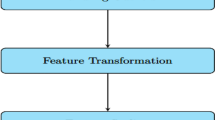Abstract
The nature of construction claims is highly complicated and the cost involved is high. It will be advantageous if the parties to a dispute may know with some certainty how the case would be resolved if it were taken to court. The recent advancements in artificial neural networks may render a cost-effective technique to help to predict the outcome of construction claims, on the basis of characteristics of cases and the corresponding past court decisions. In this paper, a split-step particle swarm optimization (PSO) model is applied to train perceptrons in order to predict the outcome of construction claims in Hong Kong. It combines the advantages of global search capability of PSO algorithm in the first step and the local convergence of back-propagation algorithm in the second step. It is shown that, through a real application case, its performance is much better than the benchmark backward propagation algorithm and the conventional PSO algorithm.
Preview
Unable to display preview. Download preview PDF.
Similar content being viewed by others
References
Chau, K.W.: Resolving Construction Disputes by Mediation: Hong Kong Experience. Journal of Management in Engineering, ASCE 8(4), 384–393 (1992)
Chau, K.W.: A Review on the Integration of Artificial Intelligence into Coastal Modeling. Journal of Environmental Management 80(1), 47–57 (2006)
Chau, K.W., Cheng, C.T.: Real-Time Prediction of Water Stage with Artificial Neural Network Approach. In: McKay, B., Slaney, J.K. (eds.) Canadian AI 2002. LNCS (LNAI), vol. 2557, pp. 715–715. Springer, Heidelberg (2002)
Cheng, C.T., Chau, K.W., Sun, Y.G., Lin, J.Y.: Long-term Prediction of Discharges in Manwan Reservoir using Artificial Neural Network Models. In: Wang, J., Liao, X.-F., Yi, Z. (eds.) ISNN 2005. LNCS, vol. 3498, pp. 1040–1045. Springer, Heidelberg (2005)
Cheng, C.T., Lin, J.Y., Sun, Y.G., Chau, K.W.: Long-Term Prediction of Discharges in Manwan Hydropower using Adaptive-Network-Based Fuzzy Inference Systems Models. In: Wang, L., Chen, K., S. Ong, Y. (eds.) ICNC 2005. LNCS, vol. 3612, pp. 1152–1161. Springer, Heidelberg (2005)
Wu, C.L., Chau, K.W.: Evaluation of Several Algorithms in Forecasting Flood. In: Ali, M., Dapoigny, R. (eds.) IEA/AIE 2006. LNCS (LNAI), vol. 4031, pp. 111–116. Springer, Heidelberg (2006)
Rumelhart, D.E., Widrow, B., Lehr, M.A.: The Basic Ideas in Neural Networks. Communications of the ACM 37(3), 87–92 (1994)
Kennedy, J., Eberhart, R.: Particle Swarm Optimization. In: Proceedings of the 1995 IEEE International Conference on Neural Networks, Perth, pp. 1942–1948 (1995)
Chau, K.W.: River Stage Forecasting with Particle Swarm Optimization. In: Orchard, B., Yang, C., Ali, M. (eds.) IEA/AIE 2004. LNCS (LNAI), vol. 3029, pp. 1166–1173. Springer, Heidelberg (2004)
Chau, K.W.: Rainfall-Runoff Correlation with Particle Swarm Optimization Algorithm. In: Yin, F.-L., Wang, J., Guo, C. (eds.) ISNN 2004. LNCS, vol. 3174, pp. 970–975. Springer, Heidelberg (2004)
Chau, K.W.: Predicting Construction Litigation Outcome using Particle Swarm Optimization. In: Ali, M., Esposito, F. (eds.) IEA/AIE 2005. LNCS (LNAI), vol. 3533, pp. 571–578. Springer, Heidelberg (2005)
Arditi, D., Oksay, F.E., Tokdemir, O.B.: Predicting the Outcome of Construction Litigation Using Neural Networks. Computer-Aided Civil and Infrastructure Engineering 13(2), 75–81 (1998)
Kennedy, J.: The Particle Swarm: Social Adaptation of Knowledge. In: Proceedings of the 1997 International Conference on Evolutionary Computation, Indianapolis, pp. 303–308 (1997)
Clerc, M., Kennedy, J.: The Particle Swarm—Explosion, Stability, and Convergence in a Multidimensional Complex Space. IEEE Transactions on Evolutionary Computation 6(1), 58–73 (2002)
Author information
Authors and Affiliations
Editor information
Editors and Affiliations
Rights and permissions
Copyright information
© 2006 Springer-Verlag Berlin Heidelberg
About this paper
Cite this paper
Chau, Kw. (2006). Prediction of Construction Litigation Outcome Using a Split-Step PSO Algorithm. In: King, I., Wang, J., Chan, LW., Wang, D. (eds) Neural Information Processing. ICONIP 2006. Lecture Notes in Computer Science, vol 4233. Springer, Berlin, Heidelberg. https://doi.org/10.1007/11893257_120
Download citation
DOI: https://doi.org/10.1007/11893257_120
Publisher Name: Springer, Berlin, Heidelberg
Print ISBN: 978-3-540-46481-5
Online ISBN: 978-3-540-46482-2
eBook Packages: Computer ScienceComputer Science (R0)




